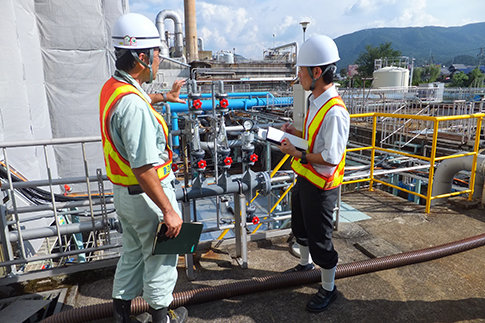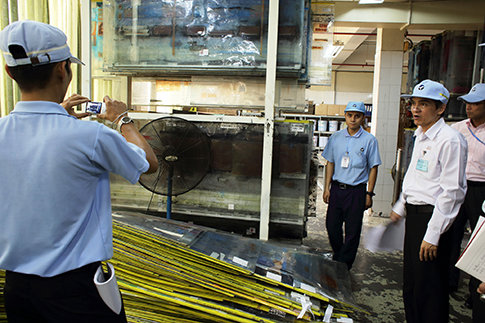Policy
Oji Group Environmental Charter
Basic Policy
The Oji Group Environmental Charter requires the Oji Group to help create a truly enriched and sustainable society by developing business activities that harmonize with the environment from a global perspective. The Charter calls for the Oji Group to make autonomous efforts to achieve further environmental improvement, and aggressively drive its forest recycling, paper recycling, and global warming countermeasures forward.
Action Guidelines
- Promotion of Forest Recycling
- Promotion of Paper Recycling
- Promotion of Global Warming Countermeasures
- Reinforcement of Environmental Improvement Measures and Environmental Management Systems
- Development of Production Technologies and Products that Minimize Environmental Impact
- Reduction and Effective Utilization of Waste
- Transfer of Environmental Protection Technology to Other Countries
- Building Relationships of Trust with Stakeholders
Representative Director of the Board
President and CEO
Oji Holdings Corporation
Hiroyuki Isono
Environmental Vision 2050
In September 2020, we established our long-term vision, “Environmental Vision 2050,” with a view toward the next 30 years. To achieve the goals outlined in Environmental Vision 2050, we are implementing a range of environmental initiatives.
Net-zero carbon
Reduce greenhouse gas (GHG) emissions to virtually zero
- Implement "Sustainable Forest Management" through the promotion of forest plantation overseas and forest conservation and achieve CO2 absorption and fixation that outweighs GHG emissions from our production activities
- Reduce GHG emissions from our production activities by improving the efficiency of energy consumption and increasing the use of renewable energy
- Reduce GHG emissions from the value chain by collaborating with our stakeholders
Aim for a recycling-oriented society
- Promote "Paper Recycling" through increasing recovered paper usage
- Promote "Water Recycling" in manufacturing processes
Harmony with nature and society
Aim for a society in harmony with nature by seeking to conserve biodiversity and reduce our impact on the environment
- Guarantee ecosystem functioning for the future by creating abundant forests and ensuring that rare plants and animals are protected and nurtured
- Promote the development and production of biodegradable and biomass materials to help maintain ecosystems
- Promote the purification of wastewater and exhaust gas and the effective use of waste
Targets and Achievements
As milestones toward achieving our long-term environmental vision, “Environmental Vision 2050,” we have established the “Environmental Action Targets 2030” and “Environmental Action Targets 2040.”
We have set specific targets for our initiatives toward carbon neutrality, nature positivity, and a circular economy, as well as for stakeholder engagement, which forms the foundation of these initiatives. We are actively working to achieve these targets.
Environmental Action Program 2040
As a new milestone of the “Environmental Vision 2050” established in 2020, we established the “Environmental Action Program 2040” in May 2025, setting FY2040 as the target year for achieving our goals.
Through the Environmental Action Program 2040, we will further advance our initiatives toward carbon neutrality, nature positivity, and a circular economy, which have been implemented under the Environmental Action Program 2030. We will also enhance our contribution to the international community while promoting stakeholder engagement as the foundation of these initiatives.
1. Action on climate change
We are committed to reducing greenhouse gas emissions by expanding the use of non-fossil energy sources. In combination with the carbon absorption effect of our company-owned forests through conservation and afforestation, we aim to achieve net-zero carbon emissions for Scope 1 and 2 by 2040*.
*We will not set an upper limit on the amount of emissions offset by forest absorption.
Targets
1) Scope 1 and 2 Greenhouse Gas (GHG) Emissions Reduction
Reducing Scope 1 and 2 GHG emissions by 50% by FY2040 compared to FY2018 levels.
Absorbing and sequestering the equivalent of 50% of FY2018 GHG emissions through our forests annually by FY2040.
1. Reduction in Energy Consumption
-
-
-
- Reducing energy consumption intensity by at least 1% annually
-
-
2. 100% Non-Fossil Electricity Procurement
-
-
-
- Achieving a 100% non-fossil electricity procurement ratio by FY2040*
-
-
* Including the use of certificates
3. Elimination of Coal Usage
-
-
-
- Eliminating coal usage by FY2040
-
-
4. Introduction of Low-Carbon Hydrogen and Other Alternatives
-
-
-
- Introducing hydrogen, ammonia, e-methane, and other alternatives
-
-
2) Scope 3 GHG emissions reduction
-
- Reducing Category 4 emissions from chip transport vessels by 40% compared to FY2018
See performance results
2. Contribution to a Nature-Positive World
We will contribute to a nature-positive world by promoting sustainable forest management to enhance the multi-faceted functions of forests, and by continuing and expanding efforts to conserve and restore ecosystems.
Targets
1) Abundant Forests Creation
-
- Sustainable Forest Management
-
-
-
- Maintaining no deforestation
- Conducting supplier due diligence at least once per year
- 100% forest certification acquisition rate and expansion of certified products
-
-
2) Biodiversity Conservation
-
- Identifying material dependencies and impacts on nature in our operations and value chain, and avoiding biodiversity loss through our business activities with consideration for ecosystems
-Restoring at least 5,000 ha of natural forests between FY2018 and FY2040
-Planting at least 900,000 seedlings of native tree species between FY2018 and FY2040
-Formulating at least 6,000 ha of ecological corridors outside own land between FY2018 and FY2040 - Collaborating with local communities, including Indigenous Peoples, and environmental NGOs to protect and nurture rare plants and animals, and to conserve and restore ecosystems
- Advancing research and development of renewable eco-friendly paper packaging and biodegradable or biomass-based materials to prevent plastic pollution
- Identifying material dependencies and impacts on nature in our operations and value chain, and avoiding biodiversity loss through our business activities with consideration for ecosystems
See performance results
3. Promotion of Circular Economy and Reducing Pollutants
We are committed to promoting the circular use of resources to contribute to the transition toward a circular economy and to continuously reducing environmental impact.
Targets
1) Promoting a Circular Economy
- Maintaining and improving an effective waste utilization rate
-Maintaining and improving an effective waste utilization rate 99% or higher in Japan and 95% or higher overseas - Promoting the use of recovered paper
-Achieving a recovered paper usage rate of 90% or higher for containerboard in Japan - Reducing total water withdrawal
-Reducing total water withdrawal by more than 10% compared to FY2018 - Engaging with stakeholders in high water-risk areas
-Conducting stakeholder engagement at least once per year in high water-risk areas - Establishing and commercializing technologies for producing fossil resource alternatives such as wood-derived sugar solution from renewable forest resources
2) Reducing Pollutants
- Reducing water pollutant impact (per company subject to measurement)
- Reducing BOD, COD, and SS emissions by 20% compared to FY2018 levels - Reducing air pollutant impact (per company subject to measurement)
-Reducing SOx emissions by 50% compared to FY2018 levels
-Reducing NOx emissions by 10% compared to FY2018 levels
-Maintaining VOC emissions intensity at FY2018 levels
See performance results
4. Stakeholder Engagement
We will expand procurement that considers the environment and society, manufacture products that contribute to a decarbonized society, and conduct business activities in compliance with environmental laws and regulations.
Targets
1) Promoting Supplier Management
-
- Strengthening supplier management systems, including third-party audits, to ensure procurement practices that respect human rights and the environment
Conducting supplier human rights and environmental due diligence at least once per year
- Strengthening supplier management systems, including third-party audits, to ensure procurement practices that respect human rights and the environment
2) Zero environment accidents and zero product liability accidents
-
- Achieving zero violations of environmental laws and regulations
- Achieving zero product liability accidents
Initiative
The Environmental Management Department is part of the Corporate Safety and Environmental Management Division of Oji Holdings (OHD Environmental Management Department) oversees the environmental audits specified in the Group Environmental Management Regulations. We identify and reduce environmental group-wide risks to prevent environmental accidents from occurring and recurring by environmental audits.
Each site, under the leadership of an Environmental Management Officer, implements a continuous PDCA (Plan-Do-Check-Act) cycle to manage environmental initiatives. These include establishing environmental policies and objectives, implementing activities, educating employees, verifying regulatory compliance, managing chemical substances and waste appropriately, providing training on waste segregation and management systems, and monitoring water conservation efforts. Through the PDCA cycle, each site continuously identifies and mitigates environmental risks.
Environmental Management System (EMS)
In a drive to encourage each worksite and company to reduce environmental risks on their own, we introduced the Environmental Management System. And we utilized a unique EMS “O-EMS” as same as third-party certifications such as ISO14001, KES and Eco Action.
Reduction of Environmental Risk
Each worksite prepares an environmental hazard map to identify potential environmental risks. By rolling out outlines, causes, and measures of environmental accidents and other incidents that occurred within one worksite to other worksites, similar environmental risks are sure to be extracted and reduced.
Environmental Audits
We conduct annual environmental audits of all production sites in Japan and overseas to evaluate environmental risks from various perspectives and to confirm compliance with environmental laws and regulations and efforts to reduce environmental risks.
Environmental audit consists of the following:
- Primary audit in which each worksite investigates and corrects problems in environmental management on its own using a check sheet.
- Secondary audit in which a company that supervises worksites (or a third-party*1) verifies the result of the primary audit. There are two types of audits: on-site audit which the auditor visits the worksite and mainly checks the site, and document audit which the auditor checks only documents. The audit type for each worksite depends on the environmental risk level and management status.
- Tertiary audit in which each group company verifies the result of the primary and secondary audits. The OHD Environmental Management Department validates the results of the tertiary audit.
- *1 We must understand and comply with different laws and regulations in each country or region. Therefore, we utilize a local staff of global third-party organizations which become well-informed on various laws and regulations.
The worksites promptly take corrective actions for any problems identified by the environmental audits, and the supervisory companies, companies and the OHD Environmental Management Department confirm the details of the corrective actions.
| Number of worksites audited | FY2018 | FY2019 | FY2020 | FY2021 | FY2022 | FY2023 | FY2024 | |
|---|---|---|---|---|---|---|---|---|
|
Primary audits (internal audits of worksites) |
Japan | 214 | 213 | 210 | 215 | 217 | 218 | 215 |
| Overseas | 58 | 58 | 60 | 61 | 65 | 65 | 75 | |
| Secondary (on-site) audits*2 | Japan | 132 | 146 | 78 | 151 | 129 | 136 | 134 |
| Overseas | 47 | 47 | 5 | 26 | 46 | 41 | 59 | |
| Environmental accidents*3 | Japan | 3 | 2 | 0 | 2 | 2 | 5 | 0 |
| Overseas | 1 | 0 | 0 | 1 | 3 | 3 | 2 |
On-site verification during environmental audits


Education and Enlightenment
Internal Environmental Newsletter
To provide environmental education and awareness to our employees, we publish a monthly environmental newsletter for all employees. We strive to raise employee awareness through such activities as our efforts to achieve zero environmental accidents and explanations of the Oji Group's environmental policy.
Examples of initiatives include: explanations of environmental management systems such as ISO 14001; efforts to reduce greenhouse gas emissions; initiatives to reduce air and water pollutants; water conservation measures; proper management and effective utilization of waste including segregation; and actions to prevent environmental incidents.